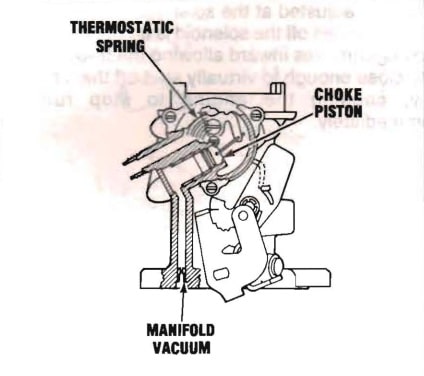The automatic choke provides the correct mixture necessary for quick cold engine starting and proper warm-up performance. When the engine is cold, tension of the thermostatic coil pulls the choke valve to the closed position. As the engine is cracked, air pressure against the offset portion of the choke valve causes the valve to open slightly against the thermostatic coil tension. Intake manifold vacuum applied to the choke piston also tends to pull the choke valve open.
When the engine starts, the choke valve assumes a position where tension of the thermostatic coil is balanced by the vacuum pull on the choke piston and force of the air stream against the offset choke valve. As the piston moves down in the cylinder, slots located in the sides of the cylinder are uncovered allowing manifold vacuum to draw warm air, heated by the exhaust manifold, through the thermostatic coil housing. This warm air causes the thermostatic spring to gradually lose its tension until the choke valve is in the wide-open position.
Some models incorporate a “shoe” on the choke piston lever which acts as a baffle to the incoming hot air to control the rate at which the thermostatic coil tension is decreased. It is part of the choke calibration.
If the engine is accelerated during the warm-up period, the corresponding drop in manifold vacuum allows the thermostatic coil to slightly close the choke to provide a richer mixture.
To prevent stalling during the warm-up period it is necessary to increase engine speed. A fast idle cam, controlled by choke valve position, holds the throttle open the correct amount to provide a balance between engine speed and engine temperature. When the choke valve is wide open, the throttle valve is permitted to return to the normal curb idle position.
If during the starting period the engine becomes flooded, the choke valve may be opened manually to clear excess fuel out of the intake manifold.
This is accomplished by moving the throttle valve to the wide-open position and cranking the engine.
Opening the throttle causes a tang on the throttle lever to contact the fast idle cam which in turn opens the choke valve to a predetermined point. This is known as the “unloader”




